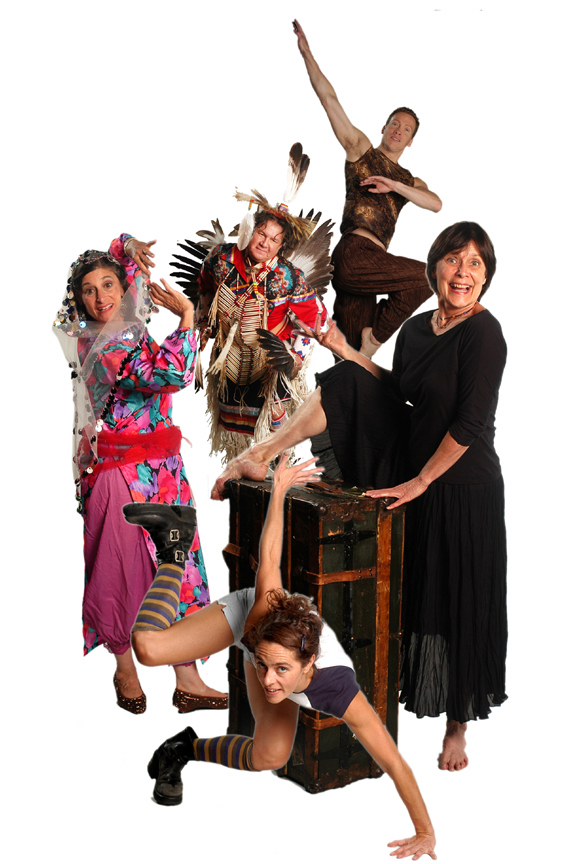“From the Horse’s Mouth”: 30 Odd Dancers at the Southern
Camille LeFevre saw this much-buzzed-about survey of Minnesota dance; it's an idiosyncratic collection of dancers / storytellers. Did it work? Mostly. You can see for yourself, on Saturday and Sunday at the Southern Theater.

“From the Horse’s Mouth” plays at 8 pm Oct. 29 as part of a benefit evening, and 7 pm Sunday Oct. 30, at the Southern Theater. See the link below for ticket and location information.
“From the Horse’s Mouth: Magical Tales of Real Dancers” is the brainchild of East Coast choreographers and directors Tina Croll and Jamie Cunningham. Since its first iteration in 1998 in New York City, the production—which juxtaposes movement and storytelling by local dancers—has been presented in Los Angeles, San Francisco, Chicago, Boston and elsewhere. The Minneapolis version, co-produced by the Southern Theater and Judith Brin Ingber, is a charming affair, despite its repetitive format and troubled beginnings.
From the start, news of “Horse’s Mouth” caused dissension in the dance community here. Was this piece about the history of the Minneapolis dance community? (No, but that didn’t stop many people from continuing to think so.) Tempers flared over who was included and who was left out. (Subsequently, changes and additions were made.) The resulting lineup of 33 performers (not all of whom are in every performance)—plus Croll and Cunningham—is a fair slice of the cultural diversity and range of dance styles currently present in the dance community.
The format is thus: A performer enters the stage, picks a microphone up off a chair, sits down and tells a two-to-three minute story that is somehow dance-related. When he or she is finished, they rise, walk over to another chair and pick an instruction out of box (reportedly, it tells them what sort of character to give their 16-count phrase of planned choreography).
They move to the spotlight area and dance as the next person tells a story. When that storyteller advances to the instruction box, the first dancer gets another instruction from another box and moves to another area of the stage. At most, there are four people on stage in ever-rotating succession: one person storytelling, another person in the spotlight, and two dancers interacting with each other with what often appears to be improvised movement. They are all dressed in black, with a flash of red.
At certain times, these performers move to the sidelines as a procession of dancers who haven’t yet told stories appear in full regalia and move diagonally across the stage: for instance, the tiny Sally Rousse in a blow-up sumo wrestler costume; Cassandra Shore in her colorful, spangled Middle Eastern garb; Don Redlich in a outrageous silver Tin Man/robot/space-age warrior get up; John Munger wearing a suit and carrying a toilet plunger; Mariusz Olszewski channeling both Michael Jackson and a tango dancer in his white garb with red hat and gloves.
Eventually, everyone tells a story, everyone dances and everyone gets to wear a costume. As is to be expected, some stories and dances are better than others. But it’s the stories—often well-honed, beautifully timed, and either comically or poignantly told—that are the most captivating part of the program. Some of my favorites included: Eric Boone’s delight in recalling his choice to attend a Catholic boy’s school, which resulted in finding his true spiritual calling in dance; Kenna-Camara Cottman’s sweet tale about buying a pet chicken for her daughter; Linda Shapiro’s quietly passionate, culturally thoughtful memoir of being partnered by a gentlemanly cadet in a bar.
I also loved Redlich’s recollection of Hanya Holm, at 98, continuing to choreograph new works in her imagination; Patrick Scully’s soothing memory of running naked down the fairways at a Roseville golf course; Kristin Van Loon’s recollection of her “most transgressive performance” as a figure skater; and Smiley Shepherd’s harrowing Vietnam experience of counting his first coup.
The most delightful text/dance moment occurred when Tamara Ober completed her pirate story with the words “not for the faint of heart,” as a prone Scully lifted a shaky Van Loon up into the air from the bottoms of her feet before she tumbled to the ground. Planned or improvised? You can never tell with those two.